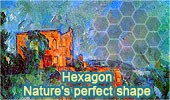|
Video Description:
"An adventure through time and space on a voyage of the Hexagon, nature's
perfect shape." Credits:
Youtube, Fnordvision
Triumph
of Hexagons and Geometry
The triumph of hexagons and geometry can be seen in
various aspects of human history, science, and art.
Hexagons are six-sided polygons with unique properties
that have fascinated mathematicians, scientists, and
artists alike. Here are some examples of the triumph of
hexagons and geometry:
Honeycomb: Honeybees
construct hexagonal cells in their hives to store honey
and raise their young. The hexagonal shape allows for
efficient use of space, maximizing storage capacity
while minimizing material usage. This remarkable
hexagonal structure has inspired mathematicians to study
its properties and has even been used in architectural
and engineering designs to optimize space usage and
structural stability.
Crystalline structures:
Hexagonal tessellations are common in crystalline
structures found in nature, such as snowflakes, basalt
columns, and quartz crystals. The hexagonal symmetry in
these structures is a result of the geometric principles
that govern their formation. This has led to extensive
research and understanding of crystallography, which has
practical applications in material science, chemistry,
and engineering.
Urban planning: Hexagons have been
used in urban planning and city design due to their
efficiency in covering large areas with minimal
overlapping and gaps. For example, the city of Palmanova
in Italy was designed in the 16th century as a fortress
with a hexagonal shape, providing optimal defense and
efficient use of space. Hexagonal grids have also been
used in modern city planning for efficient
transportation networks, zoning, and land development.
Art and design: Hexagons have been widely used in
art and design for their aesthetic appeal and geometric
symmetry. They have been featured in various forms of
art, such as tessellations, mosaics, and patterns in
textiles and ceramics. The use of hexagons in art and
design reflects the beauty and elegance of geometric
shapes in human creativity and expression.
Science and technology: Hexagons are used in various
scientific and technological applications, such as in
satellite imagery, computer graphics, and modeling of
natural phenomena. For example, hexagonal grids are used
in geographic information systems (GIS) for mapping and
analysis of spatial data. Hexagonal pixels are used in
computer graphics to efficiently represent images and
videos. Hexagonal patterns are also used in scientific
simulations and modeling of natural processes, such as
in climate science and ecological studies.
In
conclusion, the triumph of hexagons and geometry can be
seen in various fields, from nature's structures to
human-made designs, reflecting the widespread use and
appreciation of geometric principles in our world. The
inherent efficiency, symmetry, and aesthetic appeal of
hexagons make them a fascinating subject of study and
application in science, art, and technology.
Hexagons: natural and human-made
-
A beehive honeycomb.
-
The scutes of a turtle's carapace.
-
North polar hexagonal cloud feature on Saturn, discovered by Voyager 1 and confirmed in 2006 by Cassini.
-
Micrograph of a snowflake.
-
Crystal structure of a molecular hexagon composed of hexagonal aromatic rings reported by M�llen and coworkers in Chem. Eur. J., 2000, 1834-1839.
-
Naturally formed basalt columns from Giant's Causeway in Ireland.
-
An aerial view of Fort Jefferson in Dry Tortugas National Park.
-
The James Webb Space Telescope mirror is composed of 18 hexagonal segments.
-
Metropolitan France has a vaguely hexagonal shape
-
Flower of life
-
Metatron cube
-
Platonic solid.

Home |
Geometry |
Hexagon
Index |
Email
|